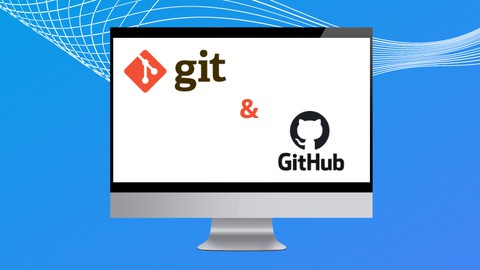
Git and GitHub – From The Beginning
Git and GitHub – From The Beginning, available at $69.99, has an average rating of 4.1, with 75 lectures, 6 quizzes, based on 47 reviews, and has 224 subscribers.
You will learn about Learn the key concepts of Git version control system. Learn and understand Git Workflow. Learn how to install and setup Git. Learn all the basic Git commands. Learn how to stage and make commits in Git. Learn how to revert commits. Learn the concept of Branching in Git. Learn how to create Aliases in Git. Learn how to merge and handle merge conflicts. Learn how to compare different version of your git repository Learn how to debug commits. Learn how to setup SSH. Learn how to connect your local repository to GitHub. Learn key GitHub concepts such as creating/cloning/forking repositories, push, pull requests, issues, labels, adding collaborators etc. And many more… This course is ideal for individuals who are Software engineers, web developers, mobile developers and freelancers interested in learning Git. or Individuals new to Git and Github. or Anyone interested in learning a version control system or This course is not for expert level Git and GitHub users. It is particularly useful for Software engineers, web developers, mobile developers and freelancers interested in learning Git. or Individuals new to Git and Github. or Anyone interested in learning a version control system or This course is not for expert level Git and GitHub users.
Enroll now: Git and GitHub – From The Beginning
Summary
Title: Git and GitHub – From The Beginning
Price: $69.99
Average Rating: 4.1
Number of Lectures: 75
Number of Quizzes: 6
Number of Published Lectures: 75
Number of Published Quizzes: 6
Number of Curriculum Items: 81
Number of Published Curriculum Objects: 81
Original Price: $89.99
Quality Status: approved
Status: Live
What You Will Learn
- Learn the key concepts of Git version control system.
- Learn and understand Git Workflow.
- Learn how to install and setup Git.
- Learn all the basic Git commands.
- Learn how to stage and make commits in Git.
- Learn how to revert commits.
- Learn the concept of Branching in Git.
- Learn how to create Aliases in Git.
- Learn how to merge and handle merge conflicts.
- Learn how to compare different version of your git repository
- Learn how to debug commits.
- Learn how to setup SSH.
- Learn how to connect your local repository to GitHub.
- Learn key GitHub concepts such as creating/cloning/forking repositories, push, pull requests, issues, labels, adding collaborators etc.
- And many more…
Who Should Attend
- Software engineers, web developers, mobile developers and freelancers interested in learning Git.
- Individuals new to Git and Github.
- Anyone interested in learning a version control system
- This course is not for expert level Git and GitHub users.
Target Audiences
- Software engineers, web developers, mobile developers and freelancers interested in learning Git.
- Individuals new to Git and Github.
- Anyone interested in learning a version control system
- This course is not for expert level Git and GitHub users.
In this course, you would learn Git and GitHub from beginner to advanced levels using a practical approach. I have tried as much as possible to make the course simple, easy to understand and beginner-friendly.
Now, what is the importance of learning git and GitHub?
If you are a developer or a software engineer and you hope to work either as a freelancer or in a software development company, then the knowledge of Git and GitHub is a MUST. This is because git is the version control system that helps you track and manage changes on a project while you collaborate with other developers. It also helps you participate and contribute to open source projects of potential employers.
But even if you don’t work in a software development company, git and GitHub would still help you manage version control in your private project and this is a good enough reason to learn Git and GitHub.
Course Approach
In this course we begin by learning the basics of git and then together, we create a project that is uploaded to GitHub. we then go into some advanced concepts.
The course is organized to cover the following
1. Basics of the command line.
2. Basics of Git
3. Practicing Git
4. Some advanced Git concepts
5. GitHub
5. Using Git in Visual Studio Code.
But what is Git?
Git is an Open Source Distributed Version Control Systemthat help developer manage changes to a project over time.
Let’s break down the keywords in the git definition above.
Git is free to download and install and you can create a GitHub account for free also.
-
Control System: This basically means that Git is a content tracker. So Git can be used to store content — it is mostly used to store code due to the other features it provides.
-
Version Control System: The code which is stored in Git keeps changing as more code is added. Also, many developers can add code in parallel. So Version Control System helps in handling this by maintaining a history of what changes have happened.
-
Distributed Version Control System: Git has a remote repository which is stored in a server and a local repository which is stored in the computer of each developer. This means that the code is not just stored in a central server, but the full copy of the code is present in all the developers’ computers. Git is a Distributed Version Control System since the code is present in every developer’s computer.
What is GitHub?
GitHub is a code hosting platform for version control and collaboration. It lets you and others work together on projects from anywhere. To get started with GitHub, you simply need to create a free GitHub account.
By the end of this course, you would be comfortable using Git and GitHub.
Course Curriculum
Chapter 1: Introduction
Lecture 1: Introduction
Lecture 2: How to get the best from this course
Lecture 3: Introduction to Git
Lecture 4: Local Repository Vs Remote Repository
Chapter 2: Git Installation and Setup
Lecture 1: Git Installation and Setup
Lecture 2: Install Visual Studio Code Editor
Chapter 3: Getting Started With Git
Lecture 1: Understanding Git Workflow
Lecture 2: Basic commands and Git Initialization
Lecture 3: Staging and Making a Commit
Lecture 4: The .git Directory
Lecture 5: Making Changes to Files
Lecture 6: Git Log and Show
Lecture 7: Git Express Commit
Lecture 8: Git Checkout
Lecture 9: More Git Log Commands 01
Lecture 10: More Git Log Commands 02
Lecture 11: Git Alias
Lecture 12: How to use the Git ignore
Lecture 13: Git Branch and merge 01
Lecture 14: Git Branch and merge 02
Lecture 15: Git Merge Conflict and how to handle them
Lecture 16: Git Tags – How To Create different versions of a project
Chapter 4: Undoing Git Commands
Lecture 1: Git Stash and how to use it
Lecture 2: Git Revert
Lecture 3: Git Reset
Lecture 4: Git diff
Chapter 5: Getting Practical With Git
Lecture 1: Git Practice: Part 01 – Working with the master branch
Lecture 2: Git Practice: Part 02 – Creating branches
Lecture 3: Git Practice: Part 03 – Working with the frontend branch
Lecture 4: Git Practice: Part 04 – Working with the Backend branch
Lecture 5: Git Practice: Part 05 – Merging all branches
Lecture 6: Git Practice: Part 06 – Creating Different Versions of a Project
Chapter 6: Connect Local repository to GitHub
Lecture 1: Creating a GitHub Account
Lecture 2: UPDATE – Set default branch to master
Lecture 3: Creating a GitHub Repository
Lecture 4: Push Local repository to GitHub
Lecture 5: Git Push Simplified
Lecture 6: Git Push Error
Lecture 7: Git Fetch VS Pull
Lecture 8: Git Clone
Lecture 9: Git Clone and Rename
Lecture 10: GitHub Settings – Rename, transfer, archive and delete repository
Lecture 11: View Commit Details on GitHub
Lecture 12: The README.md File
Chapter 7: More on GitHub
Lecture 1: Push Changes from another Branch
Lecture 2: Delete a Branch on GitHub
Lecture 3: Push Tags to GitHub
Lecture 4: Delete Tags on GitHub
Lecture 5: Create a Release on GitHub
Lecture 6: How to Fork a GitHub Project
Lecture 7: GitHub Pull Request
Lecture 8: GitHub Pull Request in Practice
Lecture 9: GitHub Collaborators
Lecture 10: GitHub Insight
Lecture 11: Creating an Issue on GitHub
Lecture 12: Closing an Issue on GitHub
Lecture 13: GitHub Labels
Lecture 14: GitHub Milestones
Lecture 15: GitHub Gist
Chapter 8: Git in Visual Studio Code Editor
Lecture 1: Introduction to the section
Lecture 2: Enable Git in Visual Studio Code
Lecture 3: Git Initialization in VS Code
Lecture 4: Staging and Making Commit in VS Code
Lecture 5: Creating Branches in VS Code
Lecture 6: Git Merge in VS Code
Lecture 7: Resolving Merge Conflicts in VS Code
Lecture 8: Comparing Changes
Lecture 9: Reverting Changes
Lecture 10: Push Local repository to GitHub from VS Code
Chapter 9: Git Merge VS Rebase
Lecture 1: Git Merge VS Rebase – Part 01
Lecture 2: Git Merge VS Rebase – Part 02
Lecture 3: Git Merge VS Rebase – Part 03
Chapter 10: Debugging in Git
Lecture 1: Debugging using git bisect
Chapter 11: Setting up SSH on GitHub
Lecture 1: Setting up SSH on GitHub
Chapter 12: Conclusion
Lecture 1: Conclusion
Instructors
-
Ewomazino Akpareva
Web Developer
Rating Distribution
- 1 stars: 0 votes
- 2 stars: 3 votes
- 3 stars: 3 votes
- 4 stars: 13 votes
- 5 stars: 28 votes
Frequently Asked Questions
How long do I have access to the course materials?
You can view and review the lecture materials indefinitely, like an on-demand channel.
Can I take my courses with me wherever I go?
Definitely! If you have an internet connection, courses on Udemy are available on any device at any time. If you don’t have an internet connection, some instructors also let their students download course lectures. That’s up to the instructor though, so make sure you get on their good side!
You may also like
- Best Emotional Intelligence Courses to Learn in March 2025
- Best Time Management Courses to Learn in March 2025
- Best Remote Work Strategies Courses to Learn in March 2025
- Best Freelancing Courses to Learn in March 2025
- Best E-commerce Strategies Courses to Learn in March 2025
- Best Personal Branding Courses to Learn in March 2025
- Best Stock Market Trading Courses to Learn in March 2025
- Best Real Estate Investing Courses to Learn in March 2025
- Best Financial Technology Courses to Learn in March 2025
- Best Agile Methodologies Courses to Learn in March 2025
- Best Project Management Courses to Learn in March 2025
- Best Leadership Skills Courses to Learn in March 2025
- Best Public Speaking Courses to Learn in March 2025
- Best Affiliate Marketing Courses to Learn in March 2025
- Best Email Marketing Courses to Learn in March 2025
- Best Social Media Management Courses to Learn in March 2025
- Best SEO Optimization Courses to Learn in March 2025
- Best Content Creation Courses to Learn in March 2025
- Best Game Development Courses to Learn in March 2025
- Best Software Testing Courses to Learn in March 2025






















